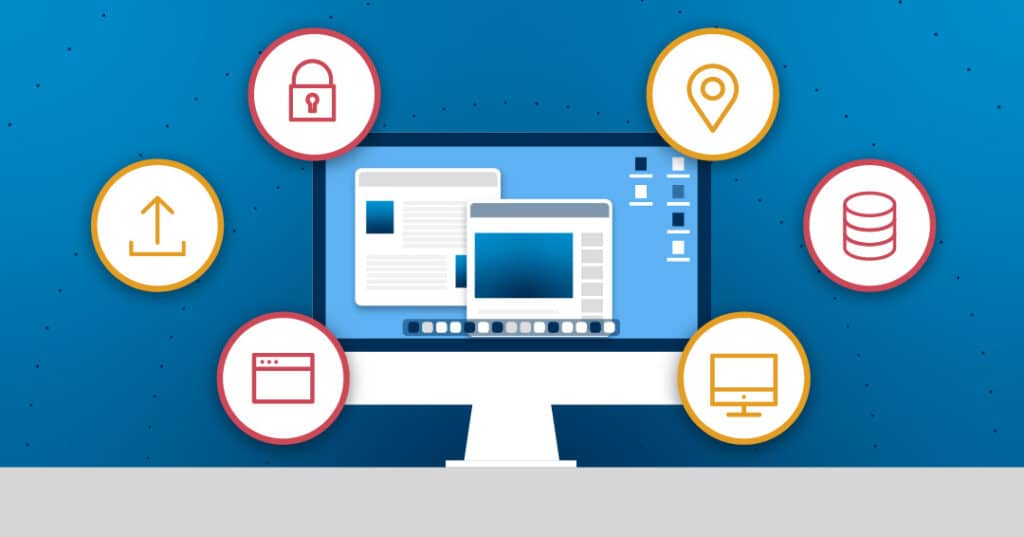Data privacy should be at the top of your list when it comes to leading your company toward expansion and innovation. An integral part of both of these is ensuring that third parties are unable to access, use, or distribute your private user data, can protect your employees, safeguard your business operations, and preserve your company’s reputation.
In all likelihood, your business faces a data privacy concern every day—if any of your employees use the internet, your company’s information could be at risk. Fortunately, in this article, we’ll break down which data are susceptible to attack, dissect six common issues in data privacy, and discuss how to solve data privacy issues to help bolster your data protection measures.
Which Data Are Susceptible to Privacy Breaches?
Privacy breaches often involve a wide range of company information. While account credentials—usernames and passwords—are likely the first pieces of information that come to mind when considering data privacy issues, plenty of other details are susceptible to access, theft, and sale.
These include:
- Products you’ve purchased online
- Search engine and browser histories
- Location information
- Financial data
- Employee benefits service providers such as:
- Insurance companies
- Health Savings Account administrators
- Retirement account platforms
- Preferred operational solutions for tasks like:
- Employee messaging
- Internal record storage
- Project management
- Banking and bookkeeping
Malicious third parties may infiltrate data and documents that you and your employees create, access, store, or share across your organization. When third parties gain access to your private information, you’re at risk of data loss, reputational damage, and regulatory fines.
That being said, you can prevent or seriously mitigate data breaches by pinpointing possible vulnerabilities and data privacy concerns within your business operations. We’ve detailed six below.
Learn more: What is Data Privacy?
#1 Insufficient Data Privacy Plans
Nearly two megabytes of new data enter the digital sphere each second. If you conduct any aspect of your business digitally or online, you contribute to that figure any time business hours are open.
But, have you considered whether or not your data protection policy and infrastructure are robust enough to handle your business’s data volume? The more data you produce, store, and share, the more likely it is that you’ll encounter data privacy issues. As such, you should consider each piece of new data as a potential weak spot in your privacy policies.
Any preventative software or procedure should address specific privacy concerns at scale. To that end, every cybersecurity and privacy solution should account for the following, at the minimum:
- The number of users and their permission throughout your network
- The sheer volume of data that your business stores physically and in the cloud
- Each employee’s average technology needs and usage
- Your company’s most critical and sensitive data
Instead of preventing issues in data privacy as an afterthought, create a plan that’s both scalable and comprehensive enough to protect your business’s unique data volume and usage. To bolster your privacy, you may encrypt your data, back up personal information on a cloud server, and implement monitoring software to regularly analyze data access and protection.
#2 Data Trading
To determine how to solve data privacy issues specific to your company, remember to account for one of the most insidious issues in the digital sphere—data trading.
Data trading includes:
- Third-party access and theft of your confidential information
- Selling the information to other third parties
- The continued sale and resale of data until relevant leaks are addressed
Protecting your sensitive data from unauthorized access—and potential sale to third parties—should be one of the linchpins of your data privacy plan. Why? Once data traders have your company or customer data, they can accomplish a variety of potentially harmful undertakings, such as:
- Identity theft – With access to enough confidential customer data, hackers can impersonate your business or your customers online for their own gain. They may issue electronic transfers from your bank accounts, apply for loans using your federal tax ID number, or make unauthorized purchases.
- Data hostaging – In extreme cases, data traders will invite you to the negotiations table by holding your data hostage for a high price. While they await your response, they may take offers from other bidders.
- Targeted advertising – Data traders can sell your data to advertising companies who can create ads personally tailored to your shopping habits, your digital shopping lists, and your search engine results.
Although it’s one of numerous data privacy issues, data sales can inconvenience, set back, or decimate your and your customers’ daily operations.
#3 Location Tracking
In the business sector, location tracking can be insidious. Hackers can infiltrate your employees’ location data to reveal or sell trade secrets, confidential consumer data, supply chain information, and business development efforts.
Let’s explore an example scenario:
- Data traders access an employee’s location data from his smartphone. The employee drives a company car to pick up orders from suppliers and deliver products to customers.
- By examining trends in his location data, third parties can uncover:
- Your primary material suppliers or consulting partners
- Your retail and individual clients
- Your company vehicle storage locations when business hours are closed
- These third parties can sell your information to data traders or offer the data to your competitors, putting your operations in jeopardy.
Hackers can wreak havoc with access to even one employee’s location data. As such, businesses must protect location data as part of their privacy initiatives.
#4 Dangers of Additional Devices
Even if on-site IT equipment is well-protected by data privacy infrastructure and procedures, consider the risks that other devices can present to your business.
In addition to work-issued smartphones, tablets, and PCs, businesses should also include the following devices in their data privacy plan:
- Employee-provided equipment, such as:
- Smartphones
- Tablets
- Laptops
- Hardware employees use to remotely access your server
- Portable hotspots for remote wifi access
The more data your company has, the more opportunities usurpers have to hijack your information—the same is true when considering the number of devices in circulation. Encourage your employees to only access company information from their work-issued devices, rather than a personal computer, phone, or tablet.
#5 Insufficient Standard Operating Procedures
Even with the best data privacy platform at their disposal, humans can still make mistakes. As such, businesses shouldn’t rely on software alone to protect their data. Companies must also develop and fine-tune standard operating procedures (SOPs) for data privacy.
SOPs should include procedures like:
- New device setup and privacy protection
- Protocol concerning employee devices
- Document naming and filing conventions
- When, why, how, and by whom the SOP should be reviewed and updated
After creating—or overhauling—their data privacy SOP, companies should also strongly consider:
- Training new employees to access and follow SOPs
- Adjusting the SOP each time their data protection software changes or updates
- Offering incentives for employees to attend semi-regular data privacy trainings
#6 Data Hoarding
As we’ve explored in previous sections, more data means more opportunities for unauthorized access. If your company is unnecessarily saving digital documents, you should perform some spring cleaning to dispose of any redundant or outdated files on your server, in the cloud, or on individual devices to prevent any privacy issues from arising.
When thinning out your data inventory, prioritize the following items for disposal:
- Duplicate files
- Program files that are outdated or no longer in use
- Non-financial documents over 10 years old
If you’re not ready to purge older materials, consider storing hard copies in a secure, safe location, like an offsite, locked storage unit. This strategy is particularly useful for old financial or HR documents—since you may need them in the future, you can reduce the risk of a data privacy issue from happening by opting for printed copies.
Why Is Data Privacy Worth It?
If the potentially massive risks posed by the data privacy issues above didn’t sway you, consider how catastrophic a personal data breach could be for your or your family’s financial security, privacy, and physical safety.
Company data should be treated with the same care, if not more—while a personal data breach could jeopardize your immediate family, a business data breach could endanger your company, your customers, and each employee.
Simply put, data privacy is worth it because:
- A data breach may lead to a loss in revenue, customer distrust, and financial penalties.
- You must comply with data privacy regulation and laws. Failure to do so may result in steep fines.
- Securing the personal information of your customers and data regarding your business operations is vital to preventing fraud, identity theft, and competitor access.
Learn more: Data Privacy vs. Data Security: A Guide
How Should You Protect Your Data?
So, wondering how to improve data privacy? Data privacy issues can be addressed with various solutions, some of which we’ve already briefly explored. These include:
- Bolster data privacy plans – To protect your digital assets thoroughly, review your current procedures and software, identify coverage gaps, and build a system that can scale as you create more data.
- Monitor data trading – Prevent data trading by reducing the likelihood of third-party data access—consider software-based solutions and internal procedures.
- Disable location tracking – Disable location services on devices company-wide to prevent data leaks and competitor access.
- Reduce devices – Limit the number of devices that can access your data and restrict employee access to company assets via personal devices.
- Create sufficient SOPs – Determine the vulnerabilities in your internal procedures, create new SOPs, and train your employees to follow them.
- Avoid data hoarding – Perform regular purges of outdated digital documents, opting for hard copies in secure storage when necessary.
Solve Your Data Privacy Issues With DataGrail
Data privacy issues can be far-reaching and can significantly endanger a company’s confidential information, its financial affairs, and its consumer privacy.
Fortunately, you can create a privacy program that protects your business’s bottom line with DataGrail. It’s the leading data privacy platform for building trust and eliminating risk with automated PII mapping and DSAR management.
At DataGrail, we’re committed to supporting compliance with evolving privacy laws and regulations, working with cloud apps like Slack, Dropbox, and Stripe. If you’re looking to gain peace of mind and create a stronger privacy program, DataGrail will work with you to build a compliant and secure data foundation. Request a demo today.
Sources:
Pew Research Center. Americans and Privacy: Concerned, Confused and Feeling Lack of Control Over Their Personal Information. https://www.pewresearch.org/internet/2019/11/15/americans-and-privacy-concerned-confused-and-feeling-lack-of-control-over-their-personal-information/
Global Brands. Internet Privacy Issues – Tracking, Hacking, and Trading. https://www.globalbrandsmagazine.com/internet-privacy-issues-tracking-hacking-and-trading/
Tech Jury. How Much Data Is Created Every Day in 2022? https://techjury.net/blog/how-much-data-is-created-every-day/#gref

